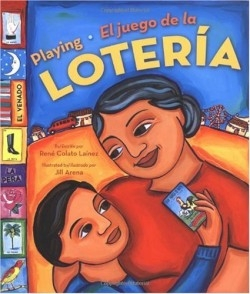El Juego de la Loteria
“‘I don’t want to stay with Grandma! I’m not used to speaking Spanish,’ I told my mom.” The boy in this story feels inadequate with the Spanish language, highlighting a common problem for children and grandchildren of immigrants.
In spite of his anxiety, the boy visits his monolingual grandmother in Mexico and enjoys her lotería booth at the fair. Lotería, a game similar to bingo, uses cards with pictures instead of numbers. The grandmother calls the cards, announcing the names of the pictures and related phrases. At the boy’s request, his grandmother teaches him the Spanish phrases for the fifty-four cards. The author, an elementary school teacher and a native of El Salvador, has been in the United States for twenty years; his other bilingual children’s books are Waiting for Papá / Esperando a Papá, and the forthcoming I Am René, the Boy / Soy René, el Niño .
In Playing Lotería, the illustrator’s first children’s book, she uses the same vivid imagery that distinguishes her work as a graphic artist. One of her charming illustrations depicts the boy and his grandmother walking, with their elbows bent and the backs of their hands on the edge of their chests, mimicking wings. Each of their open mouths forms a circle; according to the text, they are making rooster sounds. The boy has just learned the phrase for the rooster card.
After mastering the phrases, the boy takes a turn calling the cards for the lotería game. For one card, he says, “La estrella, la guía de los marineros. The star, guide for the sailors.” Thus the book goes beyond a straight bilingual text, occasionally mingling Spanish and English words and phrases within the text.
Using words from both languages with contextual clues and translations incorporated into the text, the book provides a natural means of promoting readers’ understanding. More detail in a few of the English contextual clues would have increased the benefit of this technique. Latino children who don’t speak Spanish well will find inspiration by identifying with the protagonist. Other children, ages five to eight, will enjoy learning about Hispanic culture. The final page gives rules for the lotería game.
Even though a language barrier may separate children from their extended families, readers will learn that overcoming this barrier is possible by working hard to learn their ancestral language, and that learning another language is valuable for everyone.
Disclosure: This article is not an endorsement, but a review. The publisher of this book provided free copies of the book to have their book reviewed by a professional reviewer. No fee was paid by the publisher for this review. Foreword Reviews only recommends books that we love. Foreword Magazine, Inc. is disclosing this in accordance with the Federal Trade Commission’s 16 CFR, Part 255.

